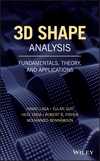3D Acquisition and Preprocessing
Summary
This chapter reviews the existing 3D acquisition techniques and systems. It particularly discusses the different characteristics that can influence decision making when it comes to selecting a system or a technique that would best suit a given application. The goal of the 3D acquisition task is to collect the geometric samples and possibly the appearance of the surface of an object. A contact 3D acquisition system produces the 3D coordinates of the surface of a subject by probing the subject through physical touch. There are two typical contact 3D acquisition systems: the coordinate measuring machine (CMM) and the arm-based 3D scanner. The chapter reviews few preprocessing algorithms which are used to reduce noise in 3D models prior to the analysis stage. It also reviews parameterization techniques, which convert 3D models represented as triangulated meshes into continuous surfaces with a well-defined parameterization domain.



